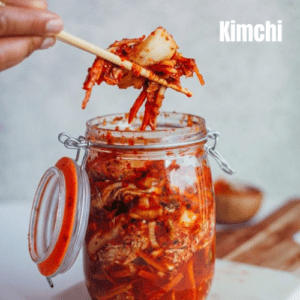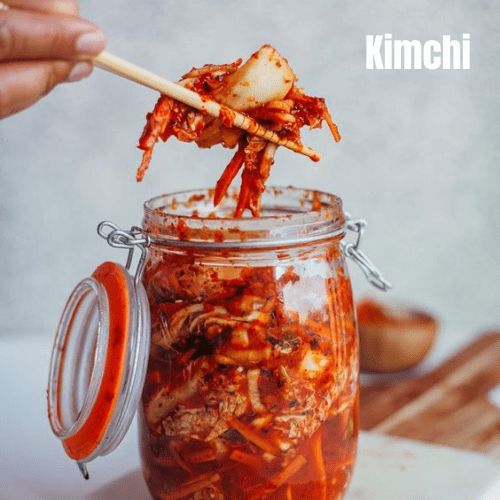Discover the bold flavors of homemade Kimchi with this easy-to-follow recipe. Kimchi, a staple in Korean cuisine, offers a tangy, spicy kick that complements any meal. With its vibrant colors and robust taste, homemade Kimchi promises to elevate your culinary adventures.
Ingredients
- Napa cabbage
- Korean red pepper flakes (gochugaru)
- Garlic
- Ginger
- Scallions
- Fish sauce
- Salt
- Sugar
- Carrots
- Radish
Steps:
- Preparing the Vegetables:
- Begin by slicing a head of Napa cabbage into bite-sized pieces. Place the cabbage in a large bowl and sprinkle it evenly with salt, massaging it gently to ensure all pieces are covered. Allow the cabbage to sit for about 2 hours to soften and release its water content. Rinse the cabbage thoroughly under cold water to remove the salt, then drain it well in a colander. This process helps to ensure the right texture and flavor development in the Kimchi.
- Making the Kimchi Paste:
- In a blender or food processor, combine Korean red pepper flakes (gochugaru), garlic cloves, ginger, scallions, fish sauce, and a bit of sugar. Blend until the mixture forms a smooth paste. Adjust the spiciness and saltiness to your preference by varying the amount of red pepper flakes and fish sauce. The paste should have a vibrant red color and a strong, savory aroma from the garlic and ginger.
- Mixing the Kimchi:
- Transfer the drained cabbage to a large mixing bowl. Add the prepared Kimchi paste to the cabbage. Using clean hands or gloves, massage the paste into the cabbage thoroughly, ensuring that every piece is coated evenly. This step is crucial for distributing the flavors throughout the Kimchi and promoting proper fermentation later on. Optionally, mix in julienned carrots and radish for added crunch and flavor variation.
- Fermentation Process:
- Pack the seasoned cabbage mixture tightly into clean, sterilized glass jars or containers, pressing down firmly to remove any air bubbles. Leave some space at the top of the container to allow for expansion during fermentation. Seal the jars tightly with lids. Leave the Kimchi to ferment at room temperature for about 1-2 days. During this time, the flavors will develop and intensify as the beneficial bacteria (lactobacilli) begin to ferment the sugars present in the vegetables.
- Storing and Aging:
- After the initial fermentation period, transfer the jars of Kimchi to the refrigerator to slow down the fermentation process. Aging Kimchi in the refrigerator for an additional few days to weeks will enhance its flavor complexity. The longer it sits, the tangier and more flavorful it will become. Kimchi can be stored in the refrigerator for several weeks to months, depending on personal preference and the desired level of fermentation.
Tips for Variation:
- Vegan Option: Substitute fish sauce with soy sauce or miso paste.
- Extra Spicy: Increase the amount of Korean red pepper flakes for a hotter kick.
- Fruit Twist: Add grated apple or pear for a hint of sweetness.
- Quick Kimchi: Skip the fermentation process for a fresher taste.
- Experiment with Vegetables: Try using bok choy or kale instead of Napa cabbage.
- Kimchi Fried Rice: Use leftover Kimchi to make flavorful fried rice dishes.
Frequently Asked Questions For Kimchi
- How long does Kimchi last in the refrigerator?
- Kimchi can last for several weeks to months when stored properly in a sealed container in the refrigerator.
- Can I adjust the spiciness of the Kimchi?
- Yes, you can adjust the amount of Korean red pepper flakes to suit your spice preference.
- Is Kimchi suitable for vegetarians?
- Traditional Kimchi includes fish sauce, but you can make it vegetarian-friendly by using alternatives like soy sauce or miso.
- What dishes can I make with Kimchi?
- Kimchi is versatile and can be used in stir-fries, soups, pancakes, and even grilled sandwiches for added flavor.
- Can I freeze Kimchi?
- Freezing may alter the texture of Kimchi, so it’s best to store it in the refrigerator for a longer shelf life.

Spice Up Your Kitchen: Homemade Kimchi Recipe for Flavorful Delight”
Kimchi, a staple in Korean cuisine, offers a tangy, spicy kick that complements any meal. With its vibrant colors and robust taste, homemade Kimchi promises to elevate your culinary adventures.
Ingredients
- Napa cabbage
- Korean red pepper flakes gochugaru
- Garlic
- Ginger
- Scallions
- Fish sauce
- Salt
- Sugar
- Carrots
- Radish
Instructions
Prepare the Cabbage:
- Slice a head of Napa cabbage into bite-sized pieces.
- Place in a large bowl, sprinkle with salt, and massage gently.
- Let sit for 2 hours, then rinse thoroughly and drain.
Make the Kimchi Paste:
- Blend Korean red pepper flakes (gochugaru), garlic, ginger, scallions, fish sauce, and sugar until smooth.
- Adjust spiciness and saltiness to taste.
Mix the Kimchi:
- Combine the drained cabbage and kimchi paste in a large bowl.
- Massage the paste into the cabbage until evenly coated.
- Optionally, add julienned carrots and radish.
Fermentation:
- Pack the mixture tightly into clean, sterilized jars, leaving space at the top.
- Seal the jars and ferment at room temperature for 1-2 days.
Storing:
- Transfer to the refrigerator to slow fermentation.
- Age for a few days to weeks for enhanced flavor.
- Store in the fridge for several weeks to months.
